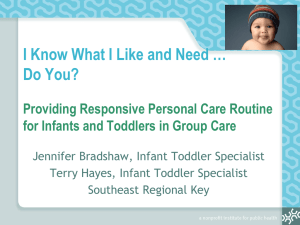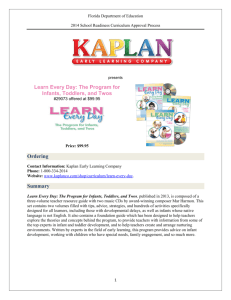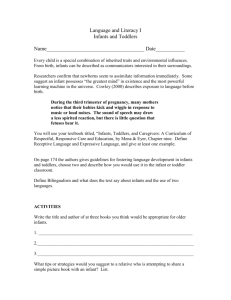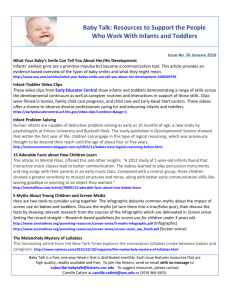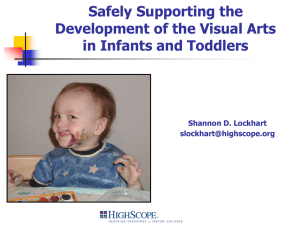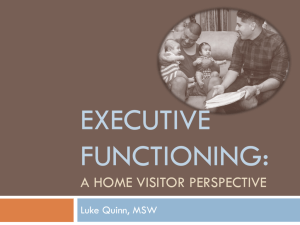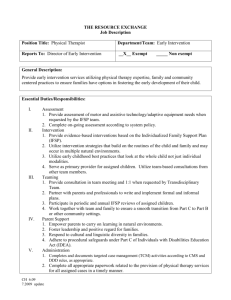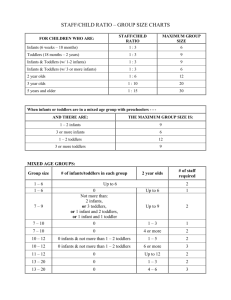The Creative Curriculum for Infants, Toddlers, & Twos
advertisement
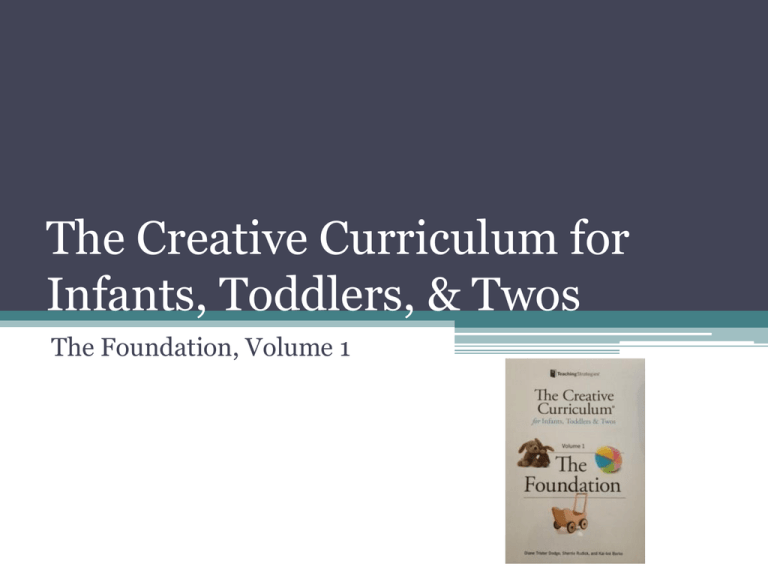
The Creative Curriculum for Infants, Toddlers, & Twos The Foundation, Volume 1 Creative Curriculum: The Foundation Knowing Infants, Toddlers, & Twos Building Partnerships With Families Caring and Teaching Theory and Research Creating a Responsive Environment What Children Are Learning Let’s take a closer look at The Creative Curriculum for Infants, Toddlers, & Twos Volume 1 The Foundation~ 5 Sections • • • • • Knowing Infants, Toddlers, & Twos Creating a Responsive Environment What Children are Learning Caring and Teaching Building Partnerships with Families Chapter 1~ Knowing Infants, Toddlers, & Twos • Reviews the developmentally appropriate expectations for young children while reviewing the Teaching Strategies GOLD Objectives and Continuum in the following areas: ▫ ▫ ▫ ▫ Social-Emotional Development Physical Development Language Development Cognitive Development Chapter 1~ Knowing Infants, Toddlers, & Twos • Understanding Individual Differences, including: ▫ ▫ ▫ ▫ Temperaments Life Circumstances Dual-Language Learners Disabilities Chapter 1 Summary • “Knowing how infants, toddlers, and twos develop is the starting point for planning your program, selecting materials, and guiding children’s development and learning. In addition to knowing how children typically develop, teachers must also learn about the unique characteristics of each child.” Chapter 2~ Creating a Responsive Environment • Setting up the Physical Environment: ▫ ▫ ▫ ▫ ▫ Creating Places for Routines and Experiences Designing Spaces for Each Age-Group Selecting Materials Displaying Materials Special Considerations in Setting Up the Physical Environment ▫ Sending Positive Messages Chapter 2~ Creating a Responsive Environment • Creating a Structure for Each Day: ▫ ▫ ▫ ▫ ▫ Planning a Daily Schedule Individualizing the Schedule for Infants Schedules for Toddlers and Twos Planning for Transitions Responsive Planning Chapter 2 Summary • Chapter two helps teachers understand the physical environment; how the environment promotes the developing abilities and interests of infants, toddlers, and twos; how the environment supports responsive relationships; and how to plan a structured routine that also allows flexibility. Chapter 3~ What Are Children Learning • The foundation for ALL Learning • Building Language and Literacy Skills, including: ▫ ▫ ▫ ▫ ▫ Vocabulary and Language The Sounds and Rhythms of Language Enjoying Books and Stories Exploring Writing Promoting Language and Literacy Learning Chapter 3~ What Are Children Learning • Discovering Mathematical Relationships: ▫ ▫ ▫ ▫ ▫ Number Concepts Patterns and Relationships Geometry and Spatial Relationships Sorting and Classifying Helping Children Discover Mathematical Relationships Chapter 3~ What Are Children Learning • Exploring Like Scientists: ▫ ▫ ▫ ▫ The Physical World The Natural World The Social World Encouraging Children to Explore Like Scientists Chapter 3 Summary • Chapter three “Explains how the experiences you provide for infants, toddlers, and twos support learning in language and literacy, math, and science and prepare children for success in school and in life.” Chapter 4~ Caring and Teaching • Building Relationships- explains how to use your knowledge of child development and individual children’s strengths and needs to build trusting, responsive relationships with and among children. Focuses on: ▫ Strategies for Building Trusting Relationships ▫ Helping Children Get Along with Others ▫ Developing a Structure that Supports Relationships ▫ Helping Children Transition to a New Group or Preschool Chapter 4~ Caring and Teaching • Promoting Children’s Self-Regulation, including: ▫ Setting the Foundation for Young Infant’s SelfRegulation ▫ Helping Mobile Infants Begin to Control Their Behavior ▫ Promoting the Self-Regulation of Toddlers and Twos ▫ Using Positive Guidance Strategies Chapter 4~ Caring and Teaching • Responding to the following Challenging Behaviors: ▫ Physical Aggression ▫ Temper Tantrums ▫ Biting Chapter 4~ Caring and Teaching • Guiding Children’s Learning by reviewing: ▫ ▫ ▫ ▫ Learning Through Play Talking With Infants, Toddlers, and Twos Extending Children’s Knowledge and Skills Including All Children Chapter 4~ Caring and Teaching • Assessing Children’s Development and Learning ▫ ▫ ▫ ▫ Observing and Collecting Facts Analyzing and Responding Evaluating Each Child’s Progress Summarizing, Planning, and Communicating Chapter 4 Summary • Chapter four reminds us that “As you observe and get to know each child, you reflect and respond to his strengths, needs, and interests; purposefully guide his behavior, support his learning, and use ongoing assessment to document his progress and to plan.” Chapter 5~ Building Partnerships With Families • Special Concerns of Families with Children Under Age 3: ▫ The Stress of Parenting an Infant ▫ Conflicting Feelings About Sharing Care ▫ Wanting to Be Part of Their Child’s Day • Getting to Know the Families: ▫ Appreciating Differences Among Families ▫ Understanding the Influence of Culture Chapter 5~ Building Partnerships With Families • Welcoming Families to Your Program: ▫ ▫ ▫ ▫ Creating a Welcoming Environment Orienting New Families Developing an Individual Care Plan for Each Child Reaching Out to All Family Members Chapter 5~ Building Partnerships With Families • Communicating With Families: ▫ ▫ ▫ ▫ Building Trust Through Daily Interactions Making the Most of Daily Exchanges Communicating in More Formal Ways Holding Conferences and Making Home Visits • Involving Families in the Program: ▫ Offering a Variety of Ways to Be Involved ▫ Participating in the Program Chapter 5~ Building Partnerships With Families • Sharing Information and Parenting Tips • Responding to Challenging Situations: ▫ ▫ ▫ ▫ Resolving Differences Working Through Conflicts Supporting Families Who Are Under Stress Supporting the Families of Children With Disabilities Chapter 5 Summary • Chapter five teaches us that when you support parents as partners in the care of their child, families are more likely to feel as though they are an important part of your program and to offer their support. Scavenger Hunt! Use The Creative Curriculum for Infants, Toddlers, & Twos Volume 1, The Foundation to answer the following questions. Use the included handout to record your answers. Scavenger Hunt! • What term does Lev Vygotsky use to describe, “The range of a child’s learning about a particular experience?” • Chapter 1 covers how to adapt to individual differences in Infants, Toddlers, and Twos, define/describe the meaning of “Biological Rhythms” and “Sensory Threshold.” Scavenger Hunt! • What are the Seven Social-Emotional Characteristics that are essential for schoolreadiness as identified by the National Center for Infants, Toddlers, and Twos found in Chapter 3?” • Find one reason why children sometimes bite and briefly describe a strategy that could be used to prevent it. Scavenger Hunt! • Describe how the Internet can be used as a formal communication with families. Congratulations!!! You have successfully completed training for Creative Curriculum Volume 1, The Foundation. Please complete the Volume 1 Scavenger Hunt form and continue on to Volume 2 Routines and Experiences training.


